Fire Emergency Preparedness: Make a Plan
Stop, Drop, and Roll is probably the one thing we remember the firefighters telling us as children when discussing fire safety. Although this is a great tip, it’s important to know that the leading cause of death in any fire is asphyxiation.
This means you can die from a lack of oxygen before the fire could even reach you. This is why fire emergency preparedness is so important.
Related: How to Handle Burns in an Emergency
Fire Emergency Preparedness
Depending on where you live, there are two types of fires you should prepare for: a home fire and a wildfire. Below you will learn how to prepare for both before they happen and what to do when they happen. I’ve provided some updated information from when I first wrote this post a couple of years ago.
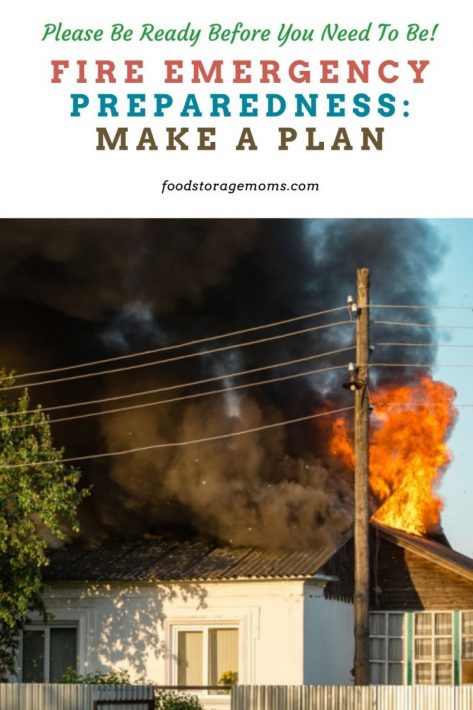
Home Fire Emergency Preparedness
Home fires are the 5th leading unintentional cause of death and injury in the United States. It is also ranked as the 1st cause of death in children under the age of 15. Most home fires occur when people are sleeping or are less likely to be alert.
This is why it’s important to be prepared for a fire before it happens. You can do this by creating a family disaster plan that includes specifics relating to fires and what to do. Your disaster plan should include the following:
Install Smoke Alarms
If you don’t already have smoke alarms in place, they should be installed outside each sleeping area. Smoke alarms cut your chances of dying in half. They are a code requirement in most areas, but older homes may not have them.
Note that in newer homes, the smoke alarms are connected in a series, so when one goes off others are set to sound the alarm too. If you install them now it may be difficult to wire them in a series, so they would be independent and probably sound the alarm in the location that registered the smoke first. For proper installation consider hiring an electrician.
Plan Escape Routes
Because most people die due to asphyxiation, it’s important to have two escape routes in place for each room of the house. Heavy, dark, smoke can cause you to become disoriented, especially if a route is blocked.
Purchase Escape Ladders
If you sleep in an upstairs bedroom, or your children do, it is important to have escape ladders. If your main escape route (your stairs) is blocked by smoke or fire, your only option is to escape through the windows. How can you do that if the drop is more dangerous than the fire?! Depending on your house, you may need a 13-foot fire escape ladder or possibly a 25-foot fire escape ladder
Not only should you purchase these ladders, but you need to practice using them. You won’t have time to learn how to use a ladder in the few minutes it may take for a fire to spread through your house. Practice ahead of time, you won’t regret it.
Windows Need to Be Easy to Open
It may be necessary based on where you live for you to have burglar bars or locks to prevent outside window entry. However, you need to make sure these bars or locks are easy to open from the inside. If you need a key to open them, keep a key inside next to each window. Be sure everyone knows where the keys are and how to use them.
You could also get quick-release devices for security bars. Keep in mind that these bars and locks also prevent firefighters from getting inside to save you. You’ll have to decide the risk/reward for this approach to home protection and safety.
Make sure windows can be opened. Older homes may have windows that haven’t been opened in a long time. They also might have been given a coat or two of paint that makes opening them difficult. Test all your windows now to make sure you and your children can open them.
If they are that old, you may want to consider an upgrade. Such a move not only improves fire safety, but newer windows are generally better insulated, thus saving you on heating and air conditioning costs that can help recoup the purchase and installation expense over time.
Set a Meeting Place
Most of the time, it is impossible for everyone to get out at the same time in the same area of the house. Make sure everyone in your home knows where to meet once they have escaped.
It needs to be a safe distance from the heat, smoke, and flames, such as across the street at a tree or a neighbor’s home. This helps you to know if anyone is still trapped inside. Families with older children should have some kind of signal in place to let parents know when they get home at night. If the parents don’t know who is home it could prove to be fatal for a family member.
Do Fire Drills
This may seem like something you don’t need, but it saves lives, especially for kids. Make sure you practice escaping a fire using both escape routes. This way there is less thinking going on if/when a fire actually happens. During the fire drill you should also:
- Practice alerting everyone that there is a fire by yelling “FIRE” several times.
- Crawl low to escape from your bedrooms as if you are crawling under smoke. Since heat rises, it helps stay safer from the heat of the fire.
- Do a drill while blindfolded, because in a real fire you most likely won’t be able to see.
- Teach your family members to get themselves out safely, first. Even one person getting out could save everyone else because they can call 911 and get help. They can also explain to the fire fighters the layout of the home and who usually occupies which rooms.
- Practice getting out both in the daytime and in the nighttime so you are prepared for both.
- Discuss fire emergency preparedness with your family!
What to Tell Children
In addition to creating the fire emergency preparedness plan above, it is important to drill some important information into your child’s head.
Children are the ones who die most frequently in house fires, therefore, it is important to discuss fire safety with them. Here are some things you should discuss and practice with them:
- Talk about when to use Stop, Drop, and Roll.
- Make sure children know that matches and lighters are tools only for adults.
- Tell your children to scream “Fire” when they see a fire starting in their home, or hear a fire alarm.
- Drill into your child to NEVER hide from a fire. Make sure they know to get out!
- Make sure they know not to try and find anything to take with them. Their goal is to get out!
- Tell them to use their second way out if their escape route is filled with smoke.
- Practice crawling low (under the smoke) with your children.
- Show them how to feel the door before opening a closed door. The back of the hand is more sensitive to heat.
- If they can’t get out using either of their escape routes, tell them to stay in a room with the door closed and window open with a sheet hanging out. This will tell firefighters where they are.
- Make sure they know where the meeting place is.
- Teach them that once they are out to STAY OUT! Many children get worried about family or pets, but they need to know they have to stay out of the house once they are safely out. A firefighter will do the rest.
How to Prevent House Fires
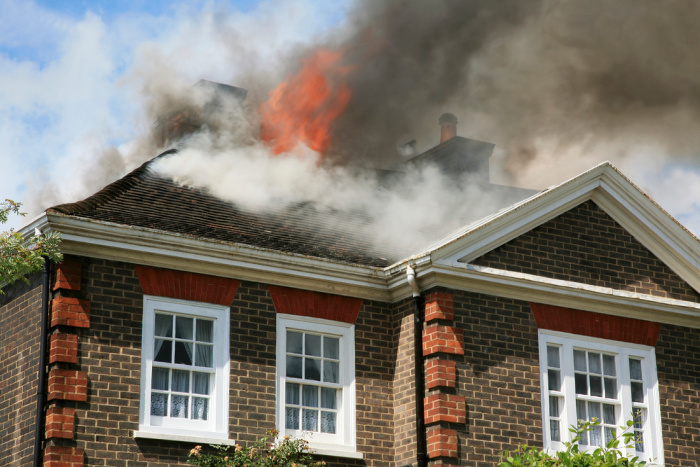
Many house fires are preventable. If you follow these tips, you may never have to worry about a fire:
- Don’t smoke in bed. You may get drowsy or fall asleep and drop the cigarette, pipe, or cigar in the bed. Also, many of us take medications right before we go to bed. This may cause you not to think clearly.
- If you are a smoker, use deep, sturdy ashtrays. Douse cigarettes with water before disposal.
- Keep matches and lighters where children can’t get to them.
- Clean your home heating source and make sure it is working properly. You want to especially make sure chimneys are clean. This should be an annual tradition before the cold weather comes your way.
- Only use portable heaters in well-ventilated rooms. Plug them into the wall socket only, and without using long extension cords or loaded surge protectors!
- Do not use kerosene heaters unless absolutely necessary.
- Get your chimneys and wood stoves inspected annually.
- Keep your stove area clean and clear of anything combustible.
- Be sure to check electrical wiring in your home, particularly if you’ve been having some circuits trip unexpectedly.
- Avoid overloading your outlets or extension cords.
- Clean dryer vents and hoses.
- Follow careful cooking habits, particularly when cooking with oils or deep fryers. Keep the kitchen free of combustibles and clutter that may catch fire.
- Keep your BBQ a safe distance from the home. If on the patio, make sure it isn’t under a ceiling made of combustibles in case the BBQ flares up with higher than usual flames. Keep extra propane tanks a safe distance from the BBQ.
- Don’t store flamable liquids in your home or a shed next to your home.
- Have a few fire extinguishers located in key areas of the home, like your kitchen, laundry room, and garage. Know how to use them, and understand that some are designed for chemical fires while others are for wood and other flamable objects.
- Never store combustibles in your furnace room, and keep anything flamable out of that area. This room, along with laundry rooms should be clutter free, as much as possible.
What to do During a Home Fire
If a fire does happen, your best course of action is to follow the plan you set in place. Get out as quickly as possible and call 911. If you have a fire extinguisher be sure to know how to use it. If the fire doesn’t immediately die down using the extinguisher, get out of the house, and again, call 911.
As you get out, be sure to close doors behind you as this prevents the spread of the fire.
What to do After a Home Fire
After a fire, you may be shaken up, but there could still be work to do. Once you have safely exited the home, call 911 to make sure emergency personnel are on the way.
Once you have called 911, check to see if anyone needs first aid, such as covering burns. Stay out of the home until fire authorities say it is safe to re-enter.
When you are able to re-enter the home, you must discard food that has been exposed to heat, smoke, or soot.
Do not discard damaged goods until inventory has been taken! As a matter of fact, as part of your plan, you should take a video inventory of every room in your house. It is very difficult to remember what is located/stored in each room after the fact. You will want to contact your insurance agent. Your insurance company should be able to offer you immediate assistance for any claims processing steps, including temporary housing if that is necessary.
WildFires: Fire Emergency Preparedness
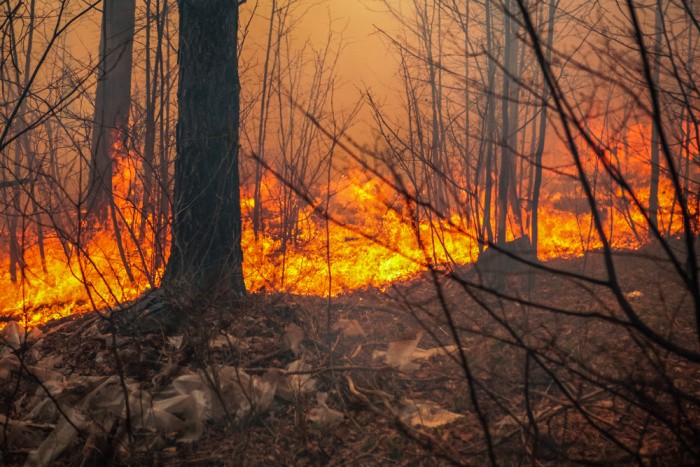
More than 72,000 communities in the United States are at risk of wildfires. Every year, wildfires spread across the U.S. damaging land and homes. Living where wildfires are a risk means you need to be prepared for them.
How to Prevent a Wildfire
As Smokey the Bear says, “Only YOU can prevent wildfires.” Most wildfires are started by carelessness. You can prevent wildfires by:
- Never play with lighters or matches.
- Always watching your campfire.
- Making sure your campfire is out before leaving it.
- Only starting a campfire in an appropriate fire pit.
- Not starting a fire on a windy day.
- Never leaving a fire unattended.
- Only burning yard waste or rubbish in a 50-gallon drum or fire pit if authorized in your community.
- Having water or a hose handy in case the fire gets out of control.
- Not spilling gas or motor oil on vegetation.
Things You Can Do to Protect Your Home
Wildfires aren’t always preventable, but we can help contain them. Here are some things you can do to protect your home from a wildfire:
- To prevent embers from igniting your home, clear leaves and other debris from gutters, eaves, porches, and decks.
- Remove dead vegetation and debris found under your deck or porch and at least 10 feet out from your house.
- To prevent debris and combustible items from accumulating, box in patios and decks with wire mesh.
- Get rid of firewood stacks and propane tanks that are within 30-feet of your home’s foundation and buildings around your house.
- Prune your trees so the lowest branches are 6 to 10 feet from the ground.
- Make sure your lawn is hydrated. If your grass is brown and dry, cut it down to reduce the fire intensity.
- Dispose of debris and lawn cuttings quickly as these are fuel for the fire.
- Cover attic vents with metal wire to prevent sparks from entering your home.
- Check your shingles and replace torn ones.
- If your home is in a very rural area, consider installing fire retardent roofing material such as tile rather than wood or asphalt shingles. That also goes for siding. Look for materials that aren’t as subject to combustion.
The more you can do to prevent the spread of fire on your property, the more likely it is for the wildfire to begin to die out. However, even with these precautions, it isn’t always possible to stop the wildfire. In many cases, you must evacuate your home.
Create an Emergency Evacuation Plan
If you live in an area where wildfires are prevalent, you should always have an emergency evacuation plan that includes the following:
- Plan two routes out of your neighborhood. This way if one area is affected by the wildfire, you have another way out.
- Designate a meeting place for you and your family members.
- Make sure everyone in your home knows where to go and how to get there if an evacuation is ordered.
- Gather emergency supplies and place them in a safe spot. Include your important documents emergency binder, medications, and first aid kit.
What to Do During a Wildfire
When there is a wildfire in your area you may not need to immediately evacuate. However, you do want to stay updated by watching and/or listening to your local media and news sources. You also want to get your family and home ready for a possible evacuation.
- Get extra clothing, blankets, and supplies packed in your vehicle.
- Place your emergency supply kit and other valuables in your vehicle.
- Do the above things to protect your home.
- Connect a garden hose and fill your pools, hot tubs, garbage cans, tubs, and other large containers with water.
- Once you have been told to evacuate, DO NOT LINGER! Leave as early as possible, before you are told to evacuate, if you can.
- You’ll always want to make sure your vehicles are at least half full of gas or electrical power so you can evacuate without worrying about fuel to get you where you need to go.
What to Do After a Wildfire Has Been Contained
Once a wildfire has been contained, you will want to continue to listen to updates from local media stations. Only return home when authorities say it is safe to do so!
FROM MATT:
I’m going to add one thing post home fire. It doesn’t matter if you were home or not. Start contacting people you know like family and close friends and let them know you’re ok. That way first responders aren’t looking for you.
If you lose your phone have a neighbor call for you or something just anything. No point in firefighters going into a shaky structure looking for bodies on a second pass if it ain’t needed or the cops trying to locate you tying up resources.
Final Word
Both house fires and wildfires can be deadly. Fires can start and spread in a matter of minutes. Whether you are in an area where wildfires happen or not, it is important to be prepared for a house fire. Make sure you and your family are prepared with an evacuation plan so you can exit your home safely.
For fire emergency preparedness you need to have a plan. Do you have your fire emergency preparedness plan in place? If not, this post should get your off to a great start. Share what your plan is in the comments below so others can get ideas. May God bless this world, Linda
Copyright Images: House roof on fire Depositphotos_33888167_S, Flames on burning house Depositphotos_383481650_S, Forest Fire Depositphotos_18327853_S

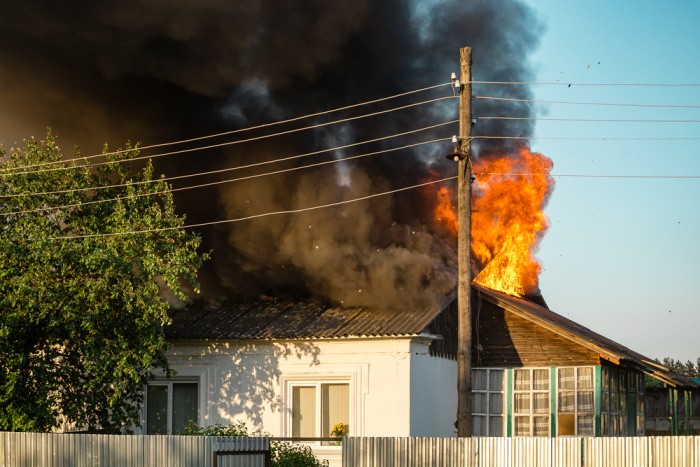



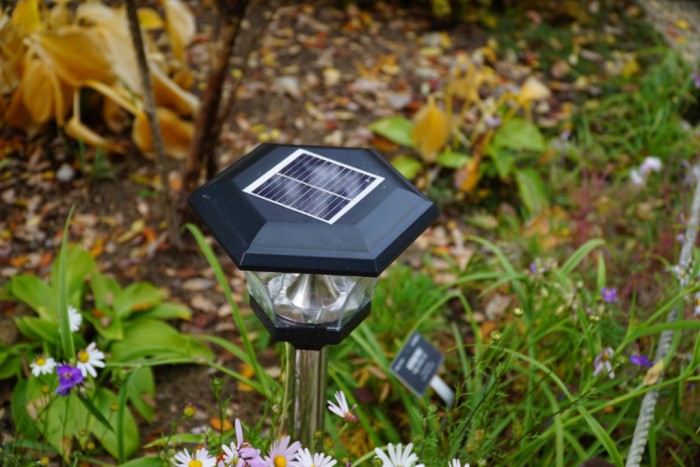
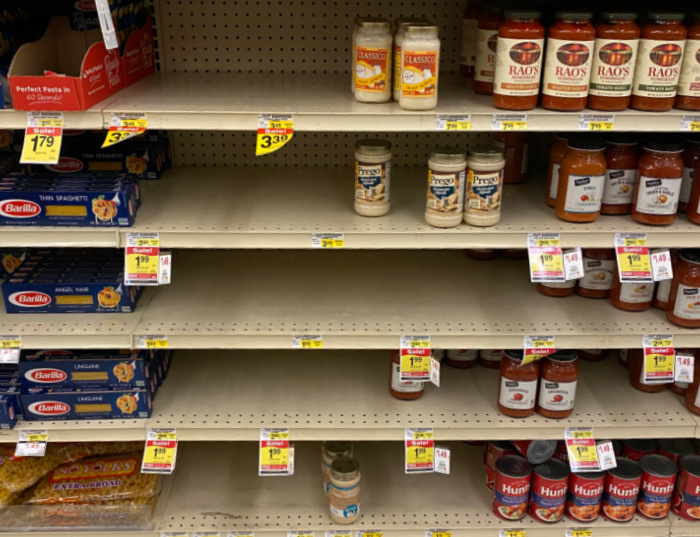















A good friend of mine lost her house to a fire this Spring. She was at work and her husband was
in the restaurant across the driveway from their house. Someone came by and seen the smoke coming out of their house and alerted the husband. They tried to put the fire out but had to call the fire department. The house was a total lose. When they went through the remains they were able to save a few things but they had all their important papers in a fire proof lock box. Not only was their house
a total loss but they live in a flood area, so when it flooded this Spring and Summer you couldn’t get to their area to rebuild. The things that got them through it all was their Faith in God, and Friends who
have helped them out. My part was when they were rebuilding one day I went to Casey’s and picked up 4 large pizza’s, and a dozen cookies. I filled a cooler with ice and Gatorade and water and headed
down to have lunch with my friend and all the workers. Another thing I did was I had extra Christmas
decorations and I gave them about 30 to hang on their tree this year. These 2 people give and give, well they have learned to take too. People have been very helpful to them. AS of now they have
a brand new house just in time for Christmas.
Hi June, what an ordeal this family went through. Thank you for sharing this great story. You stepped up to help without being asked, that’s what friends do, you are awesome. This story actually made me choke up with emotions….There are good people out there and you are a true example of that. Happy Holidays, Linda
I’m going to add one thing post home fire. It doesn’t matter if you were home or not. Start contacting people you know like family and close friends and let them know your ok. That way first responders aren’t looking for you.
If you lose your phone have a neighbor call for you or something just anything. No point in firefighters going into a shaky structure looking for bodies on a second pass if it ain’t needed or the cops trying to locate you tying up resources
Hi Matt, thanks Matt, this is critical to get the word you’re okay to everyone. Thank you for the reminder, I’m adding this to the post. Linda
With the horrific fire we had here in Colorado these last few days, this is an excellent reminder. Nearly 1,000 homes and business were destroyed or damaged. As of this morning three people are missing and presumed deceased.
Hi Anne, oh my gosh, I have been following that Colorado fire. I can’t remember a fire that has been so horrific as this one. I hadn’t heard three people are missing and presumed deceased. We need to pray for all those families and first responders. My heart is aching for all involved. Linda
Linda,
What an excellent and timely post. Having a fire plan is a crucial part of preparedness.
My dad lost his home in the Hayman fire in Colorado several years ago. His collectible cars were incinerated. Aluminum and windshield glass melted and ran in rivulets. I rebuilt his place, but his beautiful property was a blackened mess. That same fire came within a few miles of our mountain home. At night Jane and I watched fire tornadoes that were both beautiful and terrifying.
Several of my friends in Colorado had close calls in the recent wildfire, including one who fled a Target store that was destroyed. He said people were driving like maniacs, trying to outrun the flames, and it was lucky no one was killed in traffic accidents as they fled.
Hi Ray, wow, what a shame about your dad’s property and collectible cars. I cannot imagine the cleanup after a fire like that one. I helped a neighbor once wash loads of clothes after a home fire. We tried everything, we could never get the smell out of those clothes, sheets, and towels. I’m sure there are products now that we could have used. But this was about 30 years, what a mess, we would wash stuff 7-8 times and they still smelled like smoke. The walls were like a greasy mess to wash down. Now that I’m older I would hire a clean-up company. We as neighbors were worn out trying to clean up and you couldn’t even tell we had done anything. I see these fires in Colorado, and my heart aches for all involved. Can you even imagine the traffic after leaving that Target store? Wow, crazy!! Linda
Linda,
Smoke gets into the drywall, floors and everything else. That Hayman Fire was when my wife learned through personal experience that I built quality homes. The smoke was so dense and dark we had to use headlights in the middle of the day. Every home in our neighborhood reeked of smoke except ours. No smoke smell at all in ours, because our framing was tight, and our entire house was wrapped in Tyvek before the windows and door went in and the siding went on. We took in refugees from a small subdivision that burned down.
Our home was on top of a 9200′ ridge in Divide, CO and we looked South across the valley to Pikes Peak. My Facebook page shows the view from our deck.
https://www.facebook.com/ray.white.961556
It was when we looked North we could see the towering columns of smoke and, at night, the fire tornadoes. My dad’s home was burned down by a backfire set by the forest service to contain the Hayman Fire. They paid him a small “settlement” to avoid a lawsuit. The settlement paid for most of the materials to buld his new home and we footedd the labor for anything we couldn’t do ourselves.
Hi Ray, that link takes me to your main page but I can’t see the fire image. Wow, what a great feeling you must have had, knowing you built such a solid home. That settlement helped but I’m sure did not cover what you deserved. Stay well my friend, Linda
Linda,
The image is of the view from our deck, down the valley and up the back side of Pike’s Peak. I never posted any of the fire images on Facebook. I’ll send you a few.
Hi Ray, oh gotcha! Thank you! Those pictures are so sad for you and your dad. Linda
It’s best to be prepared always and nice tips you shared that home owners should follow through.
Hi IPA, thank you for your kind words, Linda